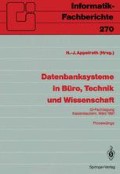Zusammenfassung
Der Informatik soll in der Wirtschaft strategisch mehr Gewicht beigemessen werden. Dies zwingt uns, implementierte und geplante Informations-Systeme integriert zu betrachten und — wenn möglich — integriert zu nutzen. Diesem Ziel dient der hier beschriebene Top-Down-Ansatz zur Modellierung von Applikations-Architekturen.
Access this chapter
Tax calculation will be finalised at checkout
Purchases are for personal use only
Preview
Unable to display preview. Download preview PDF.
Literatur
Boulanger, D.; March, S. T.: An approach to analyzing the information content of existing Databases. Data Base 20 (2), 1–8 (1989)
Brancheau, J. C; Schuster, L; March, S. T.: Building and Implementing an Information Architecture. Data Base 20(2), 9–17 (1989)
Brendel, M.: CIM im IBM-Werk Mainz. Vortrag, 1990.
Brenner, W.: Entwurf betrieblicher Datenelemente. Reihe „Betriebs- und Wirtschaftsinformatik“, Band 28. Berlin, Heidelberg: Springer. 1988.
Bullinger, H.-J.; Fähnrich K.-P.; Thines M.: Einbettung von CIM- Konzepten in ein unternehmensweites Informationsmanagement. In: Bullinger, H.-J. (Hrsg.): Tagungsband kommtech 87, Kongress III, Computer Integrated Manufacturing und Unternehmenslogistik. Velbert: ONLINE GmbH. 1987.
Give your organization new information capabilities. Data Architecture, Vol. 1, Nr. 3. Atlanta: Data Modelling Group. 1989.
De Antonellis, V.; Demo, B.: Requirements Collection and Analysis. In: Ceri, S. (Ed.): Methodology and Tools for Data Base Design. Amsterdam: North-Holland. 1983.
Hein, K. P.: Information Systems Model and Architecture Generator. IBM Systems Journal 24 (3/4), 213–135 (1985)
Martin, J.: Managing the Data-Base Environment. London: Prentice-Hall. 1983.
Mayr, H. C.; Dittrich, K. R.; Lockemann, P. C.: Datenbankentwurf. In: Lockemann, P. C; Schmidt, J. W. (Hrsg.): Datenbank-Handbuch. Berlin, Heidelberg: Springer. 1987.
McFarlan, F. W.; McKenney, J. L.: Corporate Information Systems Management. Homewood: Richard D. Irwin. 1983.
Ortner, E; Söllner, B.: Semantische Datenmodellierung nach der Objekttypenmethode. Informatik-Spektrum 12 (1), 31–42 (1989)
Rieche, H. J.; Thoma, H.: Hilfsmittel für die Systementwicklung: Erwartung und Realität — ein Erfahrungsbericht. Computer Magazin 19 (3/4), 49–54 (1990)
Scheer, A.-W.: Computer Integrated Manufacturing: CIM = Der computergesteuerte Industriebetrieb.Berlin, Heidelberg: Springer. 1987.
Scheer, A.-W.: Wirtschaftsinformatik: Informationssysteme im Industriebetrieb. Berlin, Heidelberg: Springer. 2. Aufl. 1988.
Thoma, H.: Die Rolle des Data Dictionary bei der Systemintegration. In: Oertly, F. (Hrsg.): Data Dictionaries und Entwicklungswerkzeuge für Datenbank-Anwendungen. Tagungsband DBTA/SI. Zürich: Verlag der Fachvereine. 1988.
Thoma, H.: Information Analysis: A step by step Clarification of Knowledge and Requirements. In: Karagiannis, D. (Ed.): Information Systems and Artificial Intelligence: Integration Aspects. Lecture Notes in Computer Science, Vol. 474. New York, Heidelberg: Springer. 1990.
UN/EDIFACT Rapporteurs’ Teams: Introduction to UN/EDIFACT with the latest News and Events. United Nations/ECE. April 1989.
Vetter, M.: Strategie der Anwendungssoftware-Entwicklung: Planung, Prinzipien, Konzepte. Stuttgart: Teubner. 1988.
Author information
Authors and Affiliations
Editor information
Editors and Affiliations
Rights and permissions
Copyright information
© 1991 Springer-Verlag Berlin Heidelberg
About this paper
Cite this paper
Thoma, H. (1991). Applikations-Architektur: Ein Ansatz zur Integration von Informations-Systemen. In: Appelrath, HJ. (eds) Datenbanksysteme in Büro, Technik und Wissenschaft. Informatik-Fachberichte, vol 270. Springer, Berlin, Heidelberg. https://doi.org/10.1007/978-3-642-76530-8_20
Download citation
DOI: https://doi.org/10.1007/978-3-642-76530-8_20
Publisher Name: Springer, Berlin, Heidelberg
Print ISBN: 978-3-540-53861-5
Online ISBN: 978-3-642-76530-8
eBook Packages: Springer Book Archive

